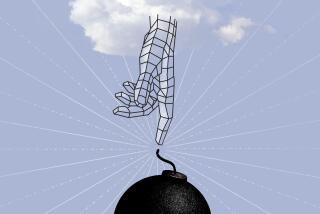Coping with the sudden rise and rapid fall of products, industries
- Share via
When asked how he went bankrupt, a character in Ernest Hemingway’s novel “The Sun Also Rises” replies: “Two ways. Gradually and then suddenly.”
This neat summation of how business failure creeps up on victims is quoted in “Big Bang Disruption: Strategy In The Age of Devastating Innovation,” a new book with more than a whiff of apocalyptic prophecy about it.
The book, published by Portfolio Hardcover, plays to the belief that technology has made established companies more prone to destruction by new entrants than ever before. Authors Larry Downes and Paul Nunes have encapsulated this in a buzz phrase — Big Bang Disruption — as anyone writing a popular business tome must do for marketing purposes.
But any reader who is not a technology obsessive is likely to be no more than half convinced by their thesis.
Noting the rapid uptake and equally fast abandonment of new personal technology such as games consoles and smartphones by consumers, Downes and Nunes theorize that Everett Rogers’ classic bell curve of demand is redundant.
Instead of anticipating smoothly rising and falling sales of new products, business must retool to cope with a “shark fin” pattern of purchasing. Here, demand is explosive and its collapse almost as precipitous.
A skeptic would argue that the shark fin is merely a bell curve with a telescoped time axis.
It is true that cycles of product development in personal technology and Web-based business are punishingly short. But it is wrong to assert that the same pattern and the same threats apply to all other industries. Venerable firms retain significant competitive advantage across a swath of sectors.
Another fallacy common within the tech industry is that we live in age of unprecedented innovation. The first shaggy warrior to have his stone weapon knocked from his hand by an early adopter with a bronze sword would have disagreed. The microprocessor is just the latest in a long line of disruptive technologies.
In the last few centuries alone we have had cast iron, canals, railways, penicillin, domestic electricity, internal combustion engines, aircraft and the telephone.
The authors correctly point out that barriers to entry have toppled in some parts of the software and Internet industries as memory has become cheaper and open-source tools and cloud-based services more available.
But as they rather uncomfortably admit, the opposite applies in pharmaceuticals, where breakthroughs are increasingly expensive. Perplexingly they blame this in part on regulation.
Personally, I am glad that groovy young drug developers cannot randomly release new treatments dreamed up during coffee-fueled “hackathons” in imitation of peers in the software business.
The criticisms above are a sign that “Big Bang Disruption” is, at the least, a stimulating read. It is carefully researched and accessibly written, if a tad breathless in style. The case studies on disruption alone are worth the cover price. These include the destruction of the pinball machine industry by computer games.
The book partly draws on research by the Accenture Institute for High Performance, of which Nunes is a managing director. Downes, meanwhile, is a consultant and coauthor of the book “Unleashing the Killer App.”
The marketing pitch for “Big Bang Destruction” is partly that it will help time-honored companies avoid annihilation at the hands of disruptive entrepreneurs. The book is a bit light on such advice. There is a section on stalling tactics. The wisdom here boils down to “sue ‘em.” The authors, one sometimes suspects, are secretly rooting for the disrupters.
Probably the best strategy for avoiding disrupters — which is not covered in the book — is to avoid vulnerable sectors such as entertainment or information retailing. Try banking instead.
Guthrie is a columnist for the Financial Times of London, in which this review first appeared.
More to Read
Inside the business of entertainment
The Wide Shot brings you news, analysis and insights on everything from streaming wars to production — and what it all means for the future.
You may occasionally receive promotional content from the Los Angeles Times.










